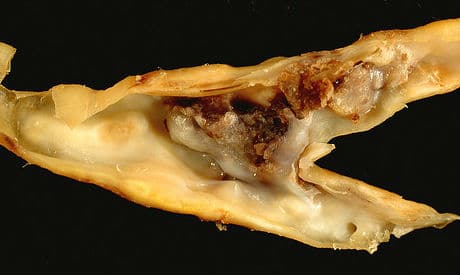
The word strikes fear in the hearts of men and women. It is defined as the hardening and clogging of arteries, leading to cardiovascular disease, meaning bad news for you and your heart. Healthy arteries are flexible and elastic blood vessels that carry oxygen and nutrients from the heart to the rest of the body. When you have atherosclerosis the inner wall of one or more arteries are damaged, blood cells and other substances often clump at the injury site and build up in the inner lining of the artery. Once the inner wall of an artery is damaged, you start to have a buildup of fatty substances, cholesterol, cellular waste products, calcium and fibrin. The buildup forms hard structures called plaque. This plaque can clog the artery, disrupting blood-flow through the body. In many cases this causes restricted blood flow to your organs and tissues which can cause tissue death. There is also a possibility that some of the plaque can break off (often caused by inflammation) and travel creating blood clots causing severe and sometimes fatal damage to other organs. Atherosclerosis is a disease that can affect any artery such as those in the heart, brain, arms, legs, pelvis, and kidneys. As a result, different diseases may develop based on which arteries are affected.
It is believed that the cause and progression of atherosclerosis is intimately related to the health of your inner arterial wall and some of the damage may be caused by:
– High cholesterol
– High Blood Pressure
– Chemical irritants such as nicotine (Smoking)
– Diabetes
– Obesity
Having a family history of heart disease and simply aging (as you age so do your arteries) can increase your risk factors for atherosclerosis. Fortunately this is preventable, as it takes years or decades to develop and starts as early as childhood. You can control some risk factors, such as an unhealthy diet, lack of physical exercise and smoking. Unfortunately, waiting for symptoms to surface is unwise. Usually by the time you have been diagnosed the situation has progressed too far for easy solutions and arteries can no longer supply adequate amounts of blood to organs & tissues. By this time surgical intervention becomes the topic of conversation.
Before reaching the tipping point where the only answer is surgery its time to make lifestyle changes. Simple lifestyle modifications can help you prevent or slow the progression of atherosclerosis.
1. Get moving
Exercising regularly keeps your arteries healthy by lowering bad cholesterol (LDL) and boosting good cholesterol (HDL). HDL acts as a scavenger, pulling bad cholesterol away from arteries. It can also help you manage your blood pressure, diabetes, weight, and stress level. Talk to your doctor about aiming for at least 30 minutes each day. Simple tricks can help, take the stairs, walk whenever possible, or park further away in a parking lot, or better yet, just walk to the store.
2. Stop smoking
Avoid smoking, and second hand smoke. The chemicals in tobacco smoke damages your blood cells and also can damage the function of your heart and the structure and function of your blood vessels.
3, Eat healthy
You knew that already. Emphasize high fiber, fresh, and unprocessed foods. Eat more fruits and vegetables (the actual fruits and vegetables not juices) and choose whole grains whenever possible. Minimize foods with sugar, saturated fat, cholesterol, sodium and avoid processed, artificial foods. Also don't forget to control your portion size.
5. Maintain a healthy weight
Reaching and maintaining a healthy weight is important for your overall health and can help prevent and control many diseases and help lower your risk risk of developing serious health problems such as heart disease, high blood pressure, type 2 diabetes, gallstones, breathing problems, and certain cancers. Avoid trendy diets that promise fast and easy weight loss. The simple adage still stands: if it sounds too good to be true, it probably is. Don't fall victim to the hype. Stop dieting altogether and start making permanent changes in your relationship with food, eating, and physical activity.
5. Relax
Life is stressful. Work, family, friends, appointments, meetings — even if you enjoy being busy, everyone needs some time off. Try to reduce your stress level at home and at work by taking some “me time” to unwind. Read a book or magazine, sleep in on the weekend, go to bed early, try meditating, try a yoga or a tai chi class or simply watch a movie. Anything that helps you unwind and recharge.
Photo Credit: euthman










